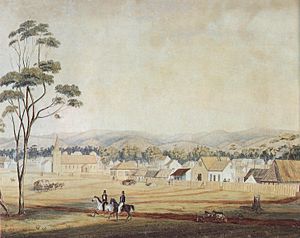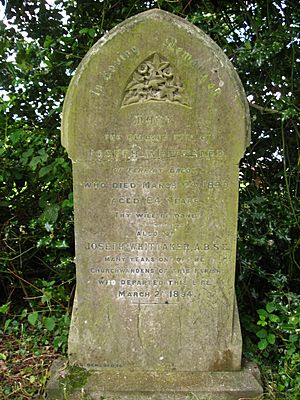Joseph Whittaker facts for kids
Quick facts for kids
Joseph Whittaker
|
|
|---|---|
| Born | 1813 Breadsall
|
| Died | 2 March 1894 |
| Nationality | British |
| Education | nurseryman |
| Occupation | schoolmaster, nurseryman |
| Known for | Flora of Australia, Flora of Derbyshire |
| Spouse(s) | Mary |
Joseph Whittaker (born 1813 – died 2 March 1894) was a British botanist. A botanist is a scientist who studies plants. He traveled to South Australia in 1839. Joseph Whittaker collected many plants during his travels. About 300 plants from his trip are now kept at Kew Gardens. He also gathered a large collection of pressed British plants. These are now at the Derby Museum and Art Gallery.
Contents
About Joseph Whittaker
His Early Life
We don't know Joseph Whittaker's exact birthday. He was christened, or baptized, on February 8, 1813. This happened in Quarndon, a village near Derby. His father was also named Joseph. His mother was Sarah, whose maiden name was Clarke. His father worked as a labourer. Some reports say Joseph was born in Breadsall in 1815.
Exploring Australian Plants
In 1838, Joseph Whittaker was working as a gardener. He sailed to Australia with his new boss, George Gawler. Gawler had just been chosen as the second Governor of South Australia. Whittaker and seven other workers from Derbyshire joined Gawler and his family. They arrived in Adelaide on October 12, 1838. Their ship was called the Pestonjee Bomanjee. The journey took four months. They stopped in Tenerife and Rio de Janeiro along the way. When they arrived, conditions were difficult. So, gardening was not the most important task.
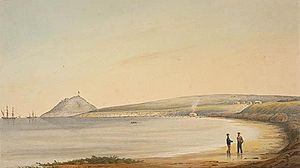
Whittaker became known for the plants he collected. He found them around Adelaide in South Australia. This was between 1839 and 1840. During his time off, Whittaker traveled to many places. He collected and carefully saved many different plant types. He visited the Mount Lofty Ranges and Mount Jagged, South Australia. He also explored the River Torrens and the Murray River. Other places he visited included the Hindmarsh River. Whittaker was the first person to seriously collect plants from this area. This included the Fleurieu Peninsula, Encounter Bay, and Mount Barker (South Australia).
Whittaker stayed in South Australia for 19 months. Then he sailed back home on a ship called the Katherine Stewart Forbes. It left Port Adelaide on April 11, 1840. On his way back, the ship stopped four times. He collected more plants at each stop. These places were Kangaroo Island, Mauritius, Saint Helena, and Corvo Island in the Azores.
Discovering Derbyshire Plants
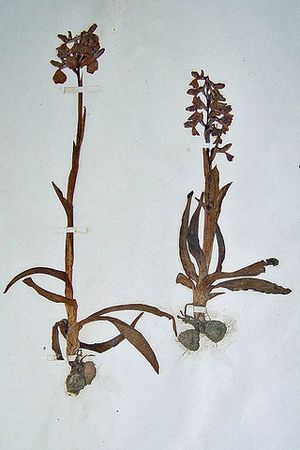
Whittaker returned to England on September 23, 1840. By 1844, he started collecting plants again. He was most active in 1851 and 1852. He stopped collecting sometime after 1867. He collected plants from many parts of Derbyshire. Sometimes, he also traveled outside the county. He visited Bulwell, Nottinghamshire, Rhyl, and Denbigh in Wales.
By 1846, he lived in Breadsall, Derbyshire. He was a schoolmaster at Breadsall Boys School. From there, he wrote to William Jackson Hooker. Hooker was the Director of the Kew Botanic Gardens. Whittaker wanted to trade some of his Australian plants. In return, he hoped to get books about British plants. Whittaker collected about 300 plants that went to Kew. His plant collections from outside the UK are now at Kew Gardens. This includes a new type of sundew plant. It was named Drosera whittakeri after him.
In February 1847, Whittaker joined the Botanical Society of London. He shared plant specimens with them from 1849 to 1853. Later, he joined other plant exchange clubs. By 1847, he had enough information to publish a list. It was called "a list of rare plants found in the neighbourhood of Breadsall, Derbyshire." This list showed the many different plants in the area.
In 1857, he was still a schoolmaster in Breadsall. He taught 90 children. Other naturalists, like Henry Harpur Crewe and Francis Sacheverel Darwin, also lived there. The Harpur-Crewe family helped pay for the school.
Whittaker lived in the small village of Morley, Derbyshire in the late 1850s. His house was called Ferriby Brook. He lived there with his wife, Mary. He continued to teach, taking up to 12 students. These students were usually between 8 and 18 years old. He eventually grew a large collection of living plants. Local gardening groups said he had over 1,300 different kinds of plants. In 1864, he wrote about the lady's slipper orchid, Cypripedium calceolus. He noted that it was disappearing from the area. He worked with Rev. Henry Harpur Crewe on this.
By 1871, he was no longer a schoolmaster. He was listed as a "seedsman and florist." By 1881, he was called a "nurseryman and farmer." He had two servants living with him. A 20-year-old named William Whitehead also lived there. Whitehead later became his business partner. Whittaker also became an 'Associate' of the Botanical Society of Edinburgh. He was a member from at least 1881 until 1891.
Whittaker's plant collecting slowed down around 1863. This was when his friend, Henry Harpur Crewe, moved away. Crewe became the Rector of Drayton Beauchamp. The next year, they worked together on a list of plants in Derbyshire. Their partnership lasted at least 18 years and was very successful. The Harpur Crewe family lived at nearby Calke Abbey. They had helped fund the school in Breadsall.
In the late 1880s, Joseph Whittaker helped William Hunt Painter. Painter was writing a book about the plants of Derbyshire. Whittaker gave him many plant samples and information. Many of Whittaker's records were also used by William Richardson Linton. Linton wrote another book about Derbyshire plants in 1903.
Whittaker passed away on March 2, 1894. A special lectern and a brass plaque were put in St Matthew's Church in Morley, Derbyshire. People donated money to honor him. He was a church warden there and was also buried there.
His Legacy
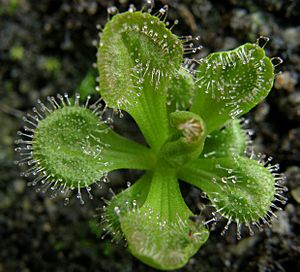
Whittaker's collection of pressed plants at Kew Gardens is from his trip to Australia. It also includes plants from the places his ship stopped on the way home. After he died, a large collection of British plants was given to the Derby Museum and Art Gallery. There were 79 volumes of these pressed plants. Most were from Derbyshire. They are now part of the museum's plant collection, called a herbarium. These plants are important for studying the plants of Derbyshire. Because he was part of plant exchange clubs, Whittaker's plants are in many UK museums. You can find them in Bolton, Birmingham, Gloucester, and Manchester. The Wisbech & Fenland Museum also has a small collection.
The carnivorous sundew plant Drosera whittakeri was named after him. A French botanist named Jules Émile Planchon described it in 1848. It is often called the scented sundew or Whittaker's sundew.


